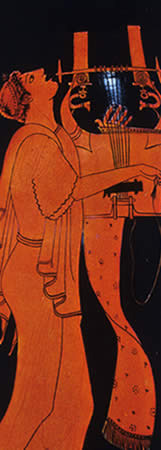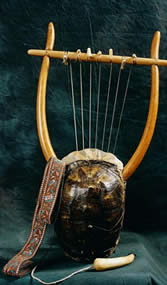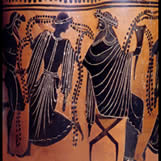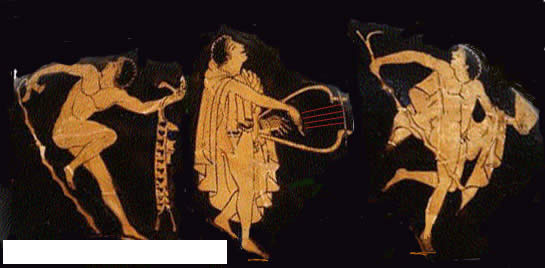
















Ancient olympia history

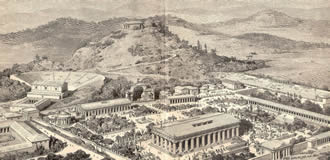
>>
Cithara
The music of ancient Greece was inseparable from poetry and dancing. It was entirely monodic, there being no harmony as the term is commonly understood. The earliest music is virtually unknown, but in the Homeric era a national musical culture existed that was looked upon by later generations as a “golden age.” The chief instrument was the phorminx, a lyre used to accompany poet-singers who composed melodies from nomoi, short traditional phrases that were repeated. The earliest known musician was Terpander of Lesbos (7th cent. B.C.). The lyric art of Archilochus , Sappho , and Anacreon was also musical in nature.
In the 6th cent. B.C., choral music was used in the drama, for which Pindar developed the classical ode . The main instruments at this time were the aulos, a type of oboe associated with the cult of Dionysus, and the kithara, a type of lyre associated with Apollo and restricted to religious and hymnic use. This classical style of composition decayed in the last quarter of the 5th cent. B.C.
Music was very important to the ancient Greeks.
They realised the geometrical nature of musical notes and did much for the development of music. Music was an important subject in education and even more imprtant for the education of young women. Music was one of the arts that women participated in actively. The lyre and the flute were the most important instruments
The music system for the Greeks involved interlocking tetrachords -- four-notes successions each spanning the interval of a perfect fourth. (Don't be confused by the term: as with the later medieval "hexachords," no "chords" or harmonies as we know them are involved.) Diatonic, chromatic, and enharmonic tetrachords are distinguishable by the intervalic placement of thirds, whole-tones, half-tones, and microtones. Additionally, to extend the available range beyond the mere fourth, two-octave spans of interlocking tetrachords made up the Greater Perfect System.
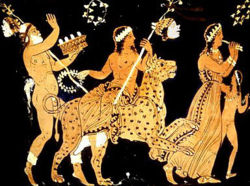
After the fall of Athens in 404 B.C., an anti-intellectual reaction took place against the classical art, and by about 320 B.C. it was almost forgotten. The new style, which resulted in the rise of professional musicians, was marked by subjective expression, free forms, more elaborate melody and rhythms, and chromaticism. The chief musical figures were Phrynis of Mitylene (c.450 B.C.), his pupil Timotheus of Miletus, and the dramatist Euripides. Finally, ancient Greek music lost its vitality and dwindled to insignificance under the Roman domination.
There were two systems of musical notation, a vocal and an instrumental, both of which are, though still problematic. They are decipherable largely because of the Introduction to Music written by Alypius (c.A.D. 360). In spite of the prominent position of music in the cultural life of ancient Greece, only 15 musical fragments are extant, all which date from the postclassical period. Early in its history, Greek music benefited from the discovery, usually attributed to Pythagoras of Samos, of the numerical relations of tones to divisions of a stretched string. The temperament, or Pythagorean tuning, derived from this series of ratios has been important throughout subsequent music history.
Pythagoras supposedly discovered the connection between music and mathematics -- that the intervals of octave, fifth, and fourth are "perfect consonances" because they can be expressed (and replicated) by the ratios 2:1, 3:2, and 4:3, respectively. Later Pythagoreans credited him also with the notion of the "music of the spheres" -- the idea that the rotation of the planetary spheres creates an inaudible harmony. Music was part of the quadrivium in the liberal arts, primarily because, along with arithmetic, geometry, and astronomy, music's mathematical nature could be emphasized. "Practicing musicians, although widely admired for their performances, were not considered among the intellectual elite: they could entertain, but they could not edify their audiences" .
